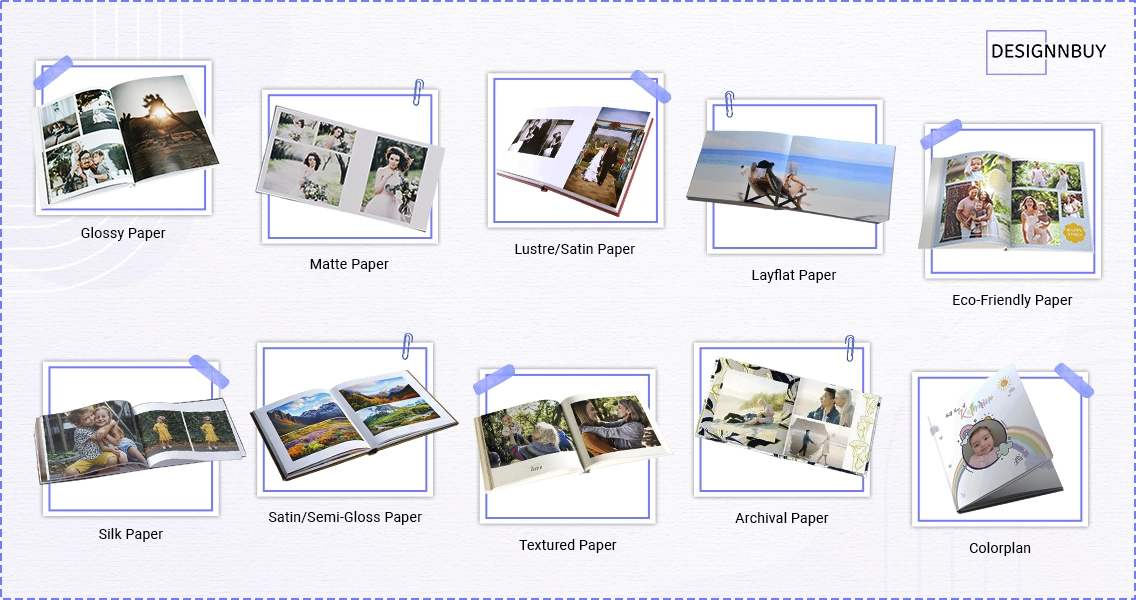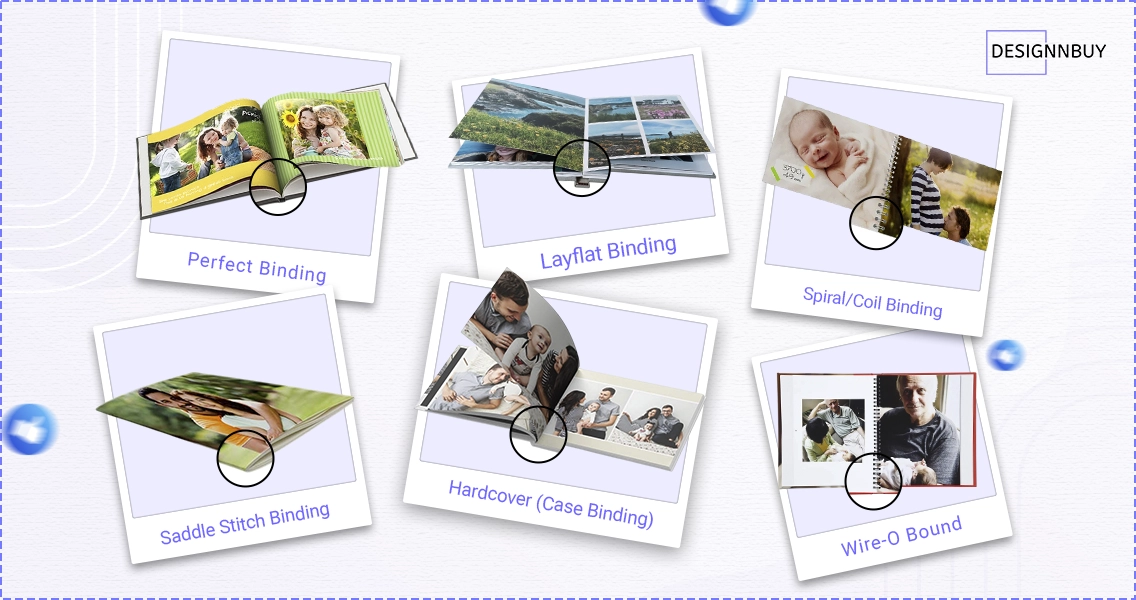In the photo book market, quality is your biggest differentiator. Customers remember sharp images, vibrant colors, and a premium feel and when you get the paper and binding right, you don’t just deliver a great product, you build trust and win repeat orders.
The right combination of paper and binding can turn every photo book into a keepsake, helping your business stand out in a competitive market while boosting customer satisfaction and loyalty.
This guide will help you understand the strengths of each paper type so you can curate the best options for your business. By offering the right mix, you’ll not only meet customer expectations but also position your photo book print shop as the go-to provider for high-quality, customizable photo books.
Table of Contents
Why Paper Choice Matters for Photo Books
The best photo book paper serves as the canvas for your memories. Different paper types dramatically affect how colors appear, how images feel to the touch, and how well your photo book withstands the test of time. The wrong paper choice can make vibrant photos appear dull, cause unwanted glare, or result in a product that feels cheap and fragile.
Photo album paper isn’t just about aesthetics it’s about preservation. The right paper stock protects your images from fading, moisture, and handling damage while enhancing the overall viewing experience. Professional photo print businesses understand that offering various paper options allows customers to create truly personalized products that match their vision and budget.
Understanding Photo Book Paper Types
When exploring photo book paper types, each option offers unique characteristics that serve different purposes and preferences. Here’s a comprehensive breakdown of the most popular options:

Glossy Paper
Glossy paper remains one of the most popular choices for photo books. This high-shine finish enhances color saturation and contrast, making images appear vibrant and crisp. The reflective surface creates depth and makes colors pop, particularly beneficial for landscape photography, portraits, and images with rich colors.
However, glossy paper can produce unwanted reflections under bright lighting and shows fingerprints easily. It’s ideal for photo books that will be displayed rather than frequently handled.
Matte Paper
Matte paper offers a non-reflective finish that eliminates glare completely. This paper type provides a sophisticated, professional appearance and handles beautifully without showing fingerprints. Matte finishes work exceptionally well for black and white photography, artistic images, and photo books intended for frequent viewing.
The trade-off is slightly muted colors compared to glossy options, but many photographers prefer this subtle, elegant look for wedding albums and professional portfolios.
Lustre/Satin Paper
Lustre paper, also known as luster paper, strikes the perfect balance between glossy and matte finishes. This popular choice offers enhanced color reproduction with minimal glare, making it versatile for various lighting conditions. The subtle texture provides an elegant feel while maintaining excellent image quality.
Lustre paper works well for most photo book applications, offering the color vibrancy of glossy paper with the handling benefits of matte finishes.
Layflat Paper
Layflat paper enables seamless panoramic spreads where images flow uninterrupted across both pages. This specialized paper type lies completely flat when opened, creating stunning double-page presentations perfect for landscape photography, wedding ceremonies, and architectural images.
The enhanced viewing experience comes with higher costs, but the dramatic impact makes layflat paper ideal for premium photo books and professional albums.
Recycled/Eco-Friendly Paper
Environmentally conscious customers increasingly seek sustainable options. Recycled paper maintains good image quality while reducing environmental impact. Modern eco-friendly papers offer comparable results to traditional options, making them excellent choices for customers prioritizing sustainability.
These papers often feature unique textures and slightly warmer tones that can enhance certain image styles, particularly vintage or artistic photography.
Silk Paper
Silk paper provides a luxurious feel with a smooth, refined finish. This premium option offers excellent color reproduction with a subtle sheen that adds elegance without excessive glare. Silk paper works beautifully for high-end photo books, wedding albums, and professional portfolios.
The sophisticated appearance and pleasant tactile experience make silk paper popular for gift photo books and special occasion albums.
Satin/Semi-Gloss Paper
Satin paper, also called semi-gloss paper, offers moderate reflection and good color saturation. This middle-ground option provides enhanced colors without the intense shine of full glossy finishes. Satin paper handles well and resists fingerprints better than glossy alternatives.
This versatile option works well for family photo books, travel albums, and general-purpose applications where good image quality and durability are priorities.
Textured Paper
Textured paper adds artistic flair with various surface patterns and feels. Options range from canvas-like textures to fine linen finishes. These papers create unique tactile experiences and can enhance artistic or vintage-style photography.
Textured papers work exceptionally well for art books, creative projects, and photo books where the paper itself contributes to the overall aesthetic experience.
Archival Paper
Archival paper prioritizes longevity and preservation. Made with acid-free materials and fade-resistant properties, this paper type ensures photo books maintain their quality for decades. Professional photographers and customers creating family heirloom albums often choose archival options.
While potentially more expensive, archival paper provides peace of mind for irreplaceable memories and professional work that needs to last.
Colorplan
Colorplan paper offers a rainbow of colored backgrounds that can dramatically enhance photo presentations. These specialty papers work well for creative projects, themed photo books, and situations where the paper color complements or contrasts with the imagery.
Available in numerous colors and finishes, Colorplan papers enable unique creative expressions impossible with traditional white papers.
How Paper Weight Affects Photo Book Quality
Paper weight, measured in GSM (grams per square meter), significantly impacts the feel, durability, and perceived quality of photo books. Heavier papers feel more substantial and luxurious, while lighter papers may seem less premium but offer practical benefits like reduced shipping costs and easier handling.
Standard photo book papers range from 150 GSM to 300+ GSM. Heavier papers resist curling, provide better opacity to prevent show-through, and create a more premium experience. However, they also increase book thickness and weight, which affects binding options and shipping costs.
The best paper stock for book applications balances quality, functionality, and cost considerations based on the intended use and target market.
Why Binding Options Matter for Photo Books
Binding determines how your photo book opens, how flat pages lie, and how well the book withstands use over time. The right binding option enhances the viewing experience while ensuring durability. Different photobook binding methods also affect production costs, turnaround times, and design possibilities.
Professional photo print businesses must understand various binding options to recommend appropriate solutions for different customer needs and budgets. The binding choice impacts everything from page count limitations to the ability to create seamless spreads.
Popular Binding Options for Photo Books

Perfect Binding
Perfect binding creates square-spined books similar to paperback novels. Pages are glued together at the spine, creating a professional appearance suitable for higher page counts. This economical option works well for catalogs, yearbooks, and thick photo books.
Perfect binding allows for spine printing, making books easily identifiable on shelves. However, pages don’t open completely flat, which can affect images that cross the center fold.
Layflat Binding
Layflat binding enables pages to lie completely flat when opened, creating seamless panoramic spreads. This premium binding option eliminates the center gutter, allowing images to flow uninterrupted across both pages. Wedding photographers and professional artists particularly value this feature.
While more expensive than standard binding, layflat construction creates dramatic presentation opportunities impossible with traditional binding methods.
Spiral/Coil Binding
Spiral binding, also called coil binding, uses plastic or metal spirals threaded through punched holes. This binding allows pages to turn 360 degrees and lie completely flat. Spiral binding works excellently for reference materials, calendars, and photo books that need to stay open at specific pages.
The casual appearance makes spiral binding less suitable for formal photo books, but its functionality excels for practical applications.
Saddle Stitch Binding
Saddle stitch binding uses staples along the folded spine to secure pages. This economical option works well for lower page counts (typically up to 64 pages) and creates books that open reasonably flat. Magazines and thin catalogs commonly use saddle stitch binding.
While cost-effective, saddle stitch binding has page count limitations and may not convey the premium feel desired for high-end photo books.
Hardcover (Case Binding)
Hardcover binding creates the most premium presentation with rigid covers that protect interior pages. Case binding involves sewing signatures together and attaching them to hard covers, resulting in durable, professional-looking books.
This binding option costs more but provides superior protection and perceived value. Hardcover photo books make excellent gifts and heirloom albums designed to last generations.
Wire-O Bound
Wire-O binding uses double-loop wire binding that allows pages to turn smoothly and lie flat. This professional binding option works well for presentations, calendars, and photo books that need to display single pages clearly.
The metal wire creates a distinctive appearance that works well for contemporary designs and professional applications.
Matching Paper & Binding for the Right Use Case
Successful photo book creation requires matching paper types and binding options to specific use cases. Wedding albums benefit from premium combinations like silk paper with layflat binding, creating luxurious keepsakes worthy of such important memories. Family photo books might use lustre paper with perfect binding, balancing quality and affordability.
Professional portfolios often feature matte paper with hardcover binding, creating sophisticated presentations that reflect the photographer’s expertise. Travel photo books might use glossy paper with spiral binding, emphasizing vibrant colors while enabling easy page-by-page viewing.
Consider your target market, intended use, handling frequency, and budget constraints when recommending paper and binding combinations. The goal is creating products that exceed customer expectations while maintaining reasonable production costs.
Special Finishing Options for Photo Books
Beyond basic binding and paper options, special finishing options can elevate photo books to extraordinary levels. Spot UV coating adds glossy highlights to specific areas while leaving other sections matte. Embossing creates raised designs that add tactile interest and premium feel.
Foil stamping applies metallic or colored foils for elegant text and design elements. These finishing touches transform ordinary photo books into luxury items that command premium pricing and create memorable experiences.
Final Thoughts: How DesignNBuy Helps Photo Print Businesses Sell Photo Books with the Right Paper & Binding
Understanding types of paper for book printing and binding options for photo books & albums, empower photo print businesses to serve customers better while increasing profitability. By offering diverse combinations of paper types for printing and photo book binding types, businesses can cater to various customer preferences and budgets.
DesignNBuy’s comprehensive photobook design software enables print businesses to offer unlimited customization options while streamlining the ordering process. Our platform supports all major paper types and binding methods, allowing customers to preview their choices and make informed decisions.
The integrated photo book software handles complex production requirements while maintaining user-friendly interfaces that encourage customer engagement. By partnering with DesignNBuy, photo print businesses can offer professional-grade custom photo books with the paper and binding options that turn memories into treasured keepsakes.
Whether customers need simple family photo albums or elaborate wedding books, the right combination of paper and binding creates products that preserve memories beautifully while building lasting customer relationships and business success.
Boost Your Photo Book Sales
Empower your print business and sell premium photo books effortlessly
Looking for more? Check out our other blogs:




